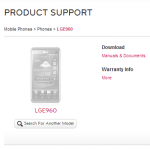NTT DOCOMO spills the beans on the LG Optimus G Pro

On Tuesday, Japanese carrier NTT DOCOMO took the wraps off its new smartphone and tablet lineup, arriving in the Spring. From the significant number of new devices that will be launched starting from January 25, one stands out from the rest -- the new LG Optimus G Pro smartphone.
NTT DOCOMO's decision to unveil the Optimus G Pro shows unfortunate timing, seeing as on the same day LG revealed plans to introduce its current flagship handset, the Optimus G, into more than 50 new markets, starting with Singapore at the end of January.
It's easier to win the lottery than buy Google Nexus 4

The Nexus 4 was anything but a secret long before Google officially raised the curtain on October 29, last year. Impressive specs, affordable price, the promise of timely upgrades, all were compelling arguments as to why I must buy one when sales start. However, Google didn't care about my enthusiasm and had other plans in mind, offering the smartphone only to a limited number of markets. Lucky me, I'm not invited to join the party. So what can I do?
Like any passionate, but patient, enthusiast my first thought was to buy one from the German Play Store, the closest one to my location and with the lowest prices as well, instead of moving to another country or shelling out more than $500 or $600 on eBay. So I asked a colleague of mine to help me out. I would pay for the Nexus 4 and he would send it my way after receiving the package. Easier said than done, obviously, as I shortly found out that Google only accepts credit cards issued in Germany. That was Plan A, by the way. OK, but now what?
Converting an LG Optimus G into a Google Nexus 4? It can be done!

When Google unveiled the Nexus 4 in late-October, the resemblance to the LG Optimus G was quite obvious. Both smartphones are manufactured by LG and share mostly the same hardware specifications (bar the full-blown 4G LTE chip, different camera module, and extra internal storage found on LG's device). So why can't the Optimus G run software designed for the Google Nexus 4? Well, as of late, it can.
The advantages of "transforming" the LG Optimus G into a Google Nexus 4, in the software department that is, are quite clear. First and foremost, users can install various custom distributions such as AOKP Jelly Bean MR1 Build 1, CyanogenMod 10.1 or even light AOSP-based builds. Second, the LG Optimus G can actually be purchased from different carriers as well as online shops, whereas the Nexus 4 even today is out of stock at Google's Play Store -- which makes the former a suitable alternative to the latter's lack of market availability.
5 things I want to see at CES 2013

Tomorrow, the Consumer Electronics Show officially kicks off, not that many vendors are waiting. There already are plenty of Day 0 and -1 announcements, which make me wonder if this -- the first of two posts -- isn't already late: What I would like and not want to see during this year's big event. If early press galas are any indication, many CES participants won't hit the jackpot in Las Vegas this year. Sadly that's a trend.
Like 2012, I'm sitting out the tradeshow. The real benefit is mingling, and that's for everyone -- from journalists to manufacturers to distributors. CES really isn't about gadget geeks but everyday consumers and CE manufacturers getting goods to them. Why else would LG's press gala feature 39 new driers and 72 refrigerators coming this year? But the big noise is all about the toys today, as it will be all week.
Android manufacturers should embrace modding

Android modding is often perceived as a rare disease that must be treated at all costs with tightly locked bootloaders and impossible to root devices. When users do want to remove the shackles imposed by manufacturers, and carriers alike, there's always a sense that someone will suddenly knock on the door and say: "Stop, we'll void your warranty. Your device must run unadulterated software!" That's just limited thinking. Modding is beneficial and not just for those roaming around in obscure corners of the interwebs.
Some argue that modding is just that insignificant other that is over-hyped per the overall scheme of things. When enthusiasts ask for unlocked bootloaders or maybe easier to root devices, those very same people will shorty argue with "Most people don't need that, so your wish doesn't matter!" Obviously there's some "truth" to that, because in most cases the deniers don't bother to read thousands of forum posts or even to check custom Android distribution statistics. Yes, there are such things.
You can have iPhone 5, I'll take Google Nexus 4

I can see only one good reason to choose iPhone 5 over Nexus 4: The LG-manufactured mobile is sold out, and you can't wait. For the patient, Google's fourth-generation stock Android delivers rewarding experience. The new Nexus is the smartphone to buy this holiday season -- if you can find one.
Two reasons stand in iPhone 5's favor, neither is good, just necessary for some people: Your carrier -- for example, Sprint and Verizon in the United States -- isn't supported (Nexus 4 is GSM/HSPA+), or you bought heap loads of apps from Apple and don't want to lose your investment. I feel your pain, but offer no pity. Nexus 4 is exceptional.
LG Optimus G, your bootloader can now be unlocked

The LG Optimus G is one of the most powerful smartphones available today, but sadly it's not the most modder-friendly device because it ships with a locked bootloader. Thanks to Project FreeGee that is no longer the case for the AT&T and Sprint versions of the South Korean smartphone that now have an unlockable bootloader.
The advantage is obvious for modders. With an unlocked bootloader owners of the AT&T and Sprint variants will be able to install Android Open Source Project-based distributions such as AOKP Jelly Bean Milestone 1 or CyanogenMod 10, once support is added. Another benefit comes from the Nexus 4 sources, which can be used to streamline the development process for compatible custom distributions, as the two devices share underpinnings.
RecoverX brings custom recovery to an impressive number of Android devices

The custom recovery plays an important role in Android modding by allowing users to install new ROMs or to perform full device backups. But finding and installing the right one can be a problem, which is where RecoverX comes into play. It comes with an impressive list of supported devices.
RecoverX offers a step-by-step guided process in order to install a custom recovery. The program only requires the brand and name of the Android smartphone or tablet, and it will display a list of available options. On a Google Galaxy Nexus, RecoverX can install ClockworkMod Recovery or ClockworkMod Touch Recovery, but depending on the device Amon-Ra Recovery and/or xRecovery is available.
LG's Nexus 4 spotted outside of Google Play with EUR599 pricetag

One of the main perks in buying a Google Nexus 4 is its attractive price. Sure, it doesn't have LTE, but it is no less of a compelling product in LTE's absence. As it turns out, the smartphone might also carry a different price tag outside of the Google Play Store.
The Phone House, which is a retailer based in Spain, gave some details concerning the local availability and price of the LG-made Nexus 4. In the Google Play Store the device retails for EUR299 for the 8GB version and EUR349 for the 16GB one, but according to The Phone House, LG's suggested retail price is actually EUR599.
Don't dismiss Google Nexus 4 for lack of LTE

Joe Wilcox is wrong. My colleague and I both own the Samsung-made Galaxy Nexus. So in theory he should see the light -- Nexus 4 is so many times better than its predecessor. For the first time in a few years Google has the brass to release a smartphone that will no longer be left for dead in a month or two by fellow Android smartphones.
Before you go all out and say that I might be insane for dismissing 4G LTE, let me be clear -- not many need it. US-hung journalists like to boast about the capability in reviews praising the high speeds. But that does not reflect the reality around the globe, where fast data speeds are not the norm nor will they be in the next year or so. Nexus 4 is so much more than missing LTE cellular connectivity, and that's rather obvious when comparing it with its predecessor. I love the Galaxy Nexus, but even I have to admit that it's rather outdated for the end of 2012.
LG Australia lists LGE960 as Google Nexus device, worst kept secret?

Four weeks ago my colleague Joe Wilcox discussed a rumor pertaining a new Google Nexus device. Just days ahead of the October 29 event that the Mountain View, Calif.-based company will hold in New York, LG Australia lists the LGE960 as a Nexus device.
The South Korean manufacturer added a support page for the LGE960, but gives away just a small amount of details. It looks to confirm that the search giant will indeed release a Nexus device that will be available for purchase online straight from the Google Play Store. Another interesting detail is that Australian carriers will also offer the device, suggesting that it may happen in other markets as well.
LG Optimus G and Samsung Galaxy Note II coming soon to Sprint

Yesterday my colleague Joe Wilcox wrote "AT&T starts LG Optimus G preorders Oct. 16, sales Nov. 2," but today Sprint announced that the LG-made quad-core power-house is coming its way, just like the controversial Samsung Galaxy Note II "phablet".
Unlike the AT&T variant the LG Optimus G will come with a 13MP camera, instead of the 8MP shooter announced yesterday, and it will be available for pre-order from November 1, with sales to start on November 11. On a two-year contract the Qualcomm-powered smartphone will cost $199. Also announced is the Samsung Galaxy Note II, that will be available for purchase on October 25 for $299.99 with a two-year contract.
AT&T starts LG Optimus G preorders Oct. 16, sales Nov. 2

AT&T's hottest smartphone of the season (well, so far) arrives in 18 days, and it's not iPhone 5. America's second-largest carrier has queued up the LG Optimus G, which will be available for $199.99 on contract -- that means two-year commitment. Optimus G specs impress, particularly that quad-core Snapdragon S4 processor, but the software somewhat disappoints. The device ships with Android 4.0.7, not successor Jelly Bean unveiled in June. Upgrade may be months away.
Older software mars what otherwise is a beauty: 4.7-inch TrueHD IPS+ display, 1280 x 768 resolution, 15:9 aspect ratio; 1.5GHz Qualcomm Snapdragon S4 Pro processor; 2GB RAM; 32GB storage (internal and card, expandable to 80GB); 8-megapixel rear-facing and 1.3MP front-facing cameras, zero-lag shutter; 4G LTE; Wi-Fi; A-GPS; MHL; DLNA; near-field communication; Bluetooth 4.0; and 2,100 mAh battery. Measures 131.9mm x 68.9mm x 8.45mm and weighs 145 grams.
When, if ever, will your LG smartphone get Android 4.1?

Jelly Bean is an elusive update for most high-end Android smartphones today, even though introduced at Google I/O four months ago. Today, LG revealed which devices will receive Android 4.1 in the upcoming months, undoubtedly in a move to catch up to the likes of HTC and Samsung that already have announced smartphones running the software.
The list of smartphones is not extensive, and includes more recent devices, such as the LG Optimus Vu and Optimus G; the latter model comes with Android 4.0 Ice Cream Sandwich and made waves in the smartphone market for its incredibly powerful hardware. The South Korean manufacturer's flagship, Qualcomm-powered, device will be updated to Jelly Bean in December.
US smartphone market consolidates around Android, iPhone

In a move appropriate for another two-party presidential election season, there is now little room for three dominant smartphone operating systems. The US market is now decisively consolidated around just two, Apple and Google platforms, as rivals -- including BlackBerry and Windows Phone -- make brisk retreats.
For the three months ended in August, Android and iOS had combined 86.9 percent smartphone subscriber share -- that's up from 82.8 percent at the end of May, according to comScore. August 2011: 71 percent. As combined share approaches 90 percent, a third-party contender looks less likely. Both potential candidates lost share during the three months, all gobbled up by the leaders.
Recent Headlines
Most Commented Stories
BetaNews, your source for breaking tech news, reviews, and in-depth reporting since 1998.
© 1998-2025 BetaNews, Inc. All Rights Reserved. About Us - Privacy Policy - Cookie Policy - Sitemap.